IB Strategy: SWOT and Porter’s Five Forces Analysis of Apple Inc.
VerifiedAdded on 2023/07/07
|22
|6284
|171
Essay
AI Summary
This essay provides a detailed analysis of Apple Inc.'s international business strategy, beginning with a company profile that outlines its background, mission, vision, values, and global scope. It examines the external environment through demographic trends, socio-cultural influences, political-legal pressures, global trade issues, macroeconomic impacts, and technological developments. A SWOT analysis identifies Apple's strengths, such as strong brand recognition, loyal customers, and innovative products, as well as weaknesses, opportunities, and threats. Furthermore, Porter's Five Forces analysis assesses the competitive intensity of the industry, considering the threat of new entrants, bargaining power of buyers and suppliers, the threat of substitutes, and the intensity of rivalry. The essay concludes by summarizing Apple's strategic position and outlook in the global market.
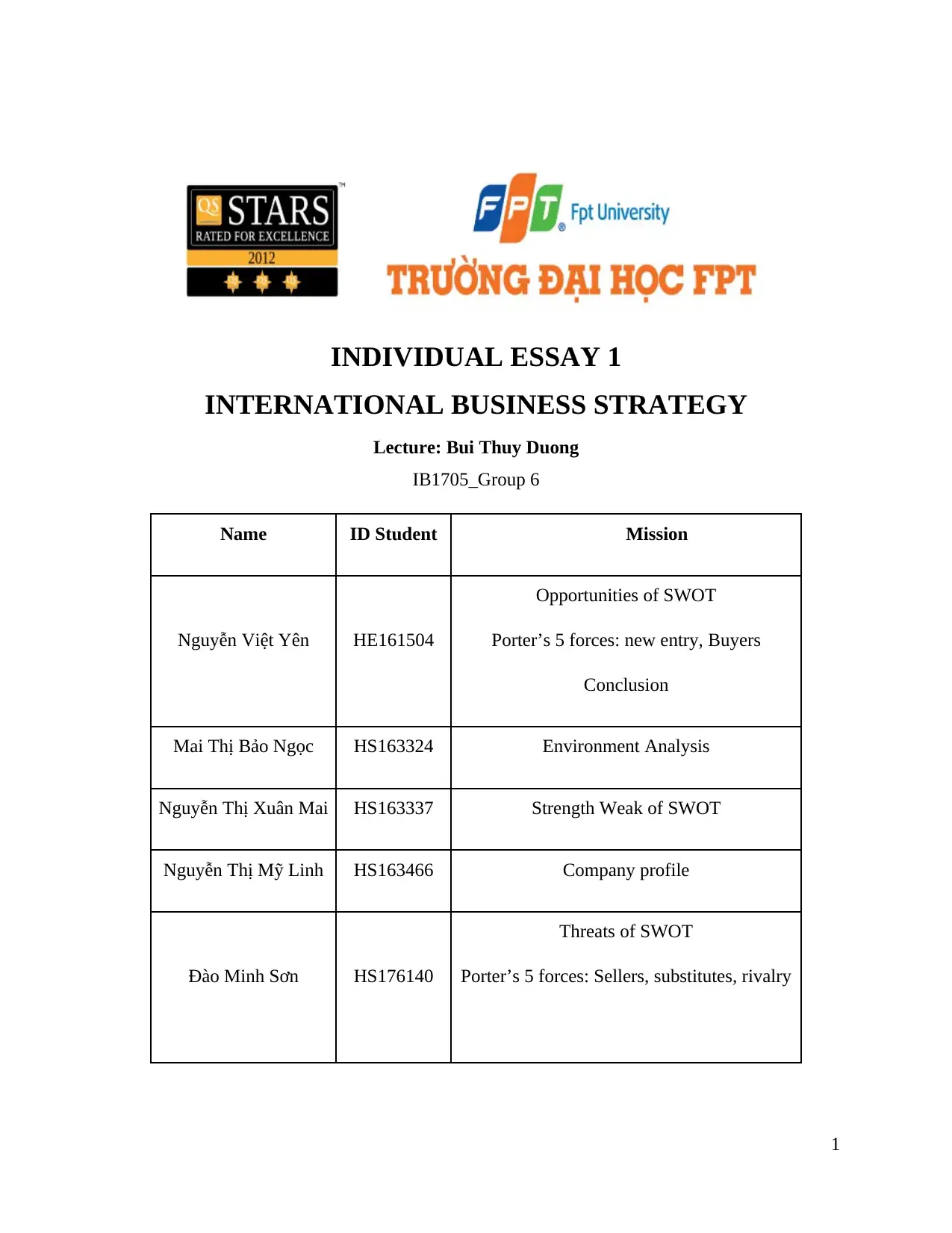
INDIVIDUAL ESSAY 1
INTERNATIONAL BUSINESS STRATEGY
Lecture: Bui Thuy Duong
IB1705_Group 6
Name ID Student Mission
Nguyễn Việt Yên HE161504
Opportunities of SWOT
Porter’s 5 forces: new entry, Buyers
Conclusion
Mai Thị Bảo Ngọc HS163324 Environment Analysis
Nguyễn Thị Xuân Mai HS163337 Strength Weak of SWOT
Nguyễn Thị Mỹ Linh HS163466 Company profile
Đào Minh Sơn HS176140
Threats of SWOT
Porter’s 5 forces: Sellers, substitutes, rivalry
1
INTERNATIONAL BUSINESS STRATEGY
Lecture: Bui Thuy Duong
IB1705_Group 6
Name ID Student Mission
Nguyễn Việt Yên HE161504
Opportunities of SWOT
Porter’s 5 forces: new entry, Buyers
Conclusion
Mai Thị Bảo Ngọc HS163324 Environment Analysis
Nguyễn Thị Xuân Mai HS163337 Strength Weak of SWOT
Nguyễn Thị Mỹ Linh HS163466 Company profile
Đào Minh Sơn HS176140
Threats of SWOT
Porter’s 5 forces: Sellers, substitutes, rivalry
1
Paraphrase This Document
Need a fresh take? Get an instant paraphrase of this document with our AI Paraphraser
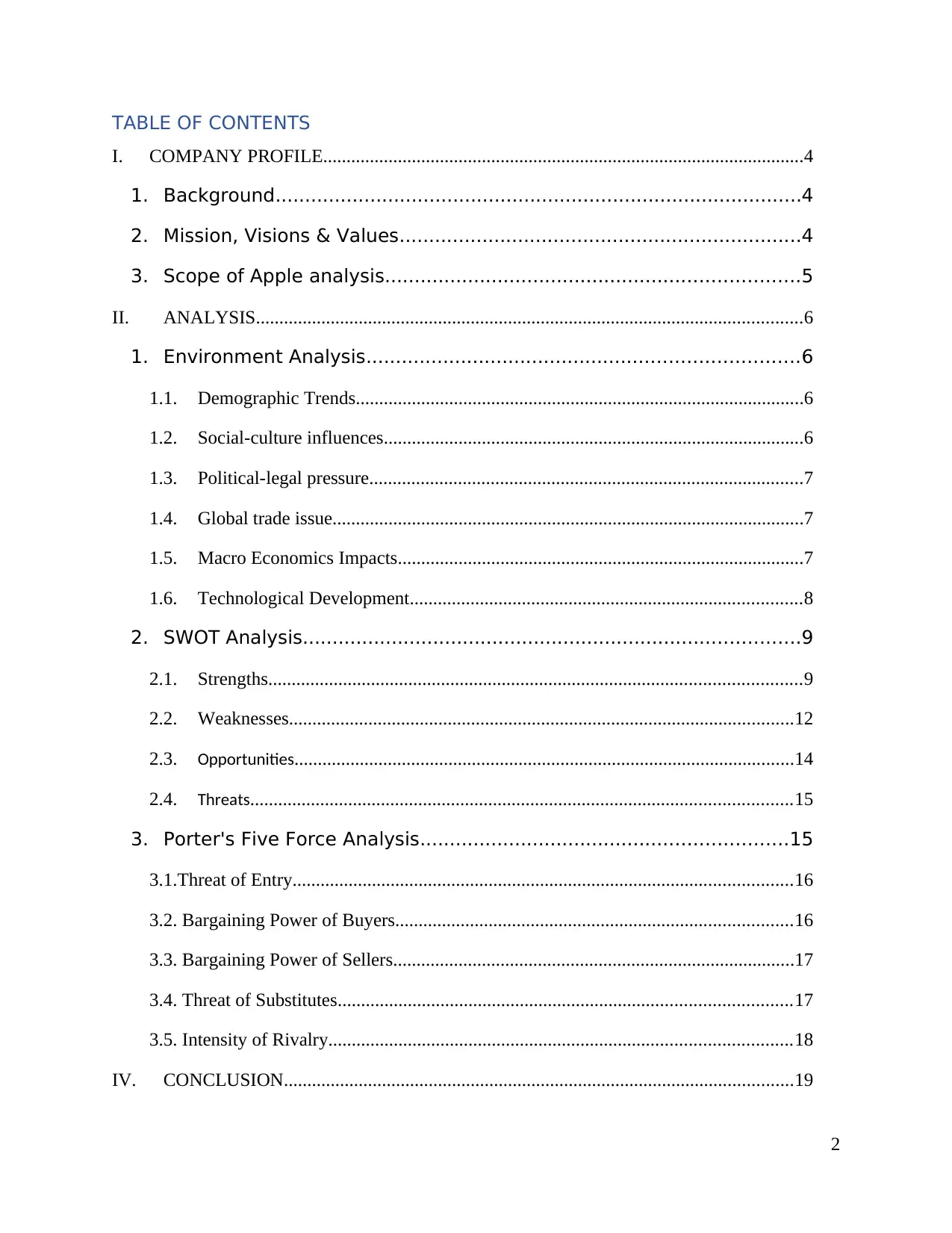
TABLE OF CONTENTS
I. COMPANY PROFILE.......................................................................................................4
1. Background.........................................................................................4
2. Mission, Visions & Values....................................................................4
3. Scope of Apple analysis......................................................................5
II. ANALYSIS.....................................................................................................................6
1. Environment Analysis.........................................................................6
1.1. Demographic Trends................................................................................................6
1.2. Social-culture influences..........................................................................................6
1.3. Political-legal pressure.............................................................................................7
1.4. Global trade issue.....................................................................................................7
1.5. Macro Economics Impacts.......................................................................................7
1.6. Technological Development....................................................................................8
2. SWOT Analysis....................................................................................9
2.1. Strengths..................................................................................................................9
2.2. Weaknesses............................................................................................................12
2.3. Opportunities...........................................................................................................14
2.4. Threats....................................................................................................................15
3. Porter's Five Force Analysis..............................................................15
3.1.Threat of Entry...........................................................................................................16
3.2. Bargaining Power of Buyers.....................................................................................16
3.3. Bargaining Power of Sellers......................................................................................17
3.4. Threat of Substitutes.................................................................................................17
3.5. Intensity of Rivalry...................................................................................................18
IV. CONCLUSION.............................................................................................................19
2
I. COMPANY PROFILE.......................................................................................................4
1. Background.........................................................................................4
2. Mission, Visions & Values....................................................................4
3. Scope of Apple analysis......................................................................5
II. ANALYSIS.....................................................................................................................6
1. Environment Analysis.........................................................................6
1.1. Demographic Trends................................................................................................6
1.2. Social-culture influences..........................................................................................6
1.3. Political-legal pressure.............................................................................................7
1.4. Global trade issue.....................................................................................................7
1.5. Macro Economics Impacts.......................................................................................7
1.6. Technological Development....................................................................................8
2. SWOT Analysis....................................................................................9
2.1. Strengths..................................................................................................................9
2.2. Weaknesses............................................................................................................12
2.3. Opportunities...........................................................................................................14
2.4. Threats....................................................................................................................15
3. Porter's Five Force Analysis..............................................................15
3.1.Threat of Entry...........................................................................................................16
3.2. Bargaining Power of Buyers.....................................................................................16
3.3. Bargaining Power of Sellers......................................................................................17
3.4. Threat of Substitutes.................................................................................................17
3.5. Intensity of Rivalry...................................................................................................18
IV. CONCLUSION.............................................................................................................19
2

V. REFERENCES..............................................................................................................19
VI. GRADES ON GROUPMATES....................................................................................21
3
VI. GRADES ON GROUPMATES....................................................................................21
3
⊘ This is a preview!⊘
Do you want full access?
Subscribe today to unlock all pages.

Trusted by 1+ million students worldwide
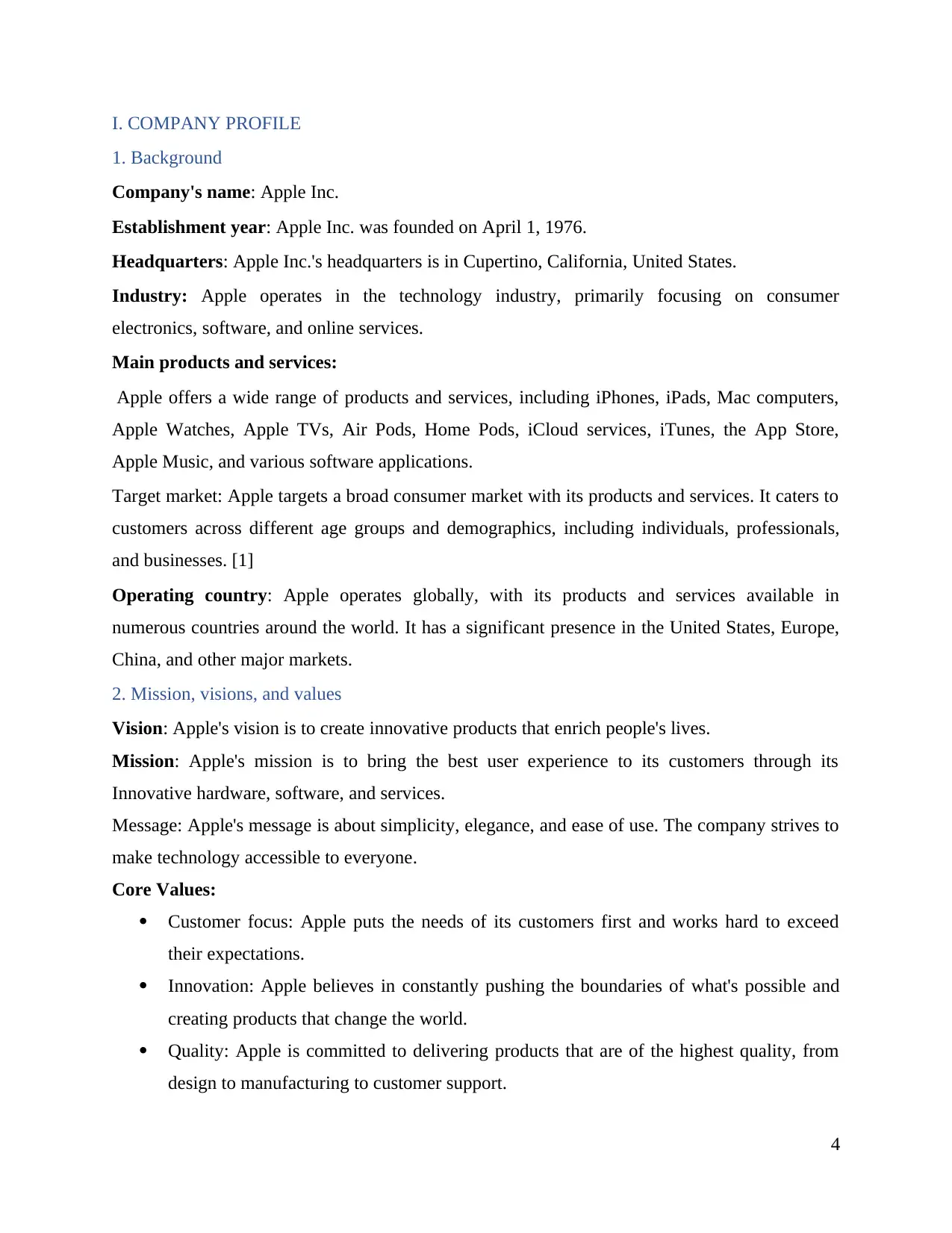
I. COMPANY PROFILE
1. Background
Company's name: Apple Inc.
Establishment year: Apple Inc. was founded on April 1, 1976.
Headquarters: Apple Inc.'s headquarters is in Cupertino, California, United States.
Industry: Apple operates in the technology industry, primarily focusing on consumer
electronics, software, and online services.
Main products and services:
Apple offers a wide range of products and services, including iPhones, iPads, Mac computers,
Apple Watches, Apple TVs, Air Pods, Home Pods, iCloud services, iTunes, the App Store,
Apple Music, and various software applications.
Target market: Apple targets a broad consumer market with its products and services. It caters to
customers across different age groups and demographics, including individuals, professionals,
and businesses. [1]
Operating country: Apple operates globally, with its products and services available in
numerous countries around the world. It has a significant presence in the United States, Europe,
China, and other major markets.
2. Mission, visions, and values
Vision: Apple's vision is to create innovative products that enrich people's lives.
Mission: Apple's mission is to bring the best user experience to its customers through its
Innovative hardware, software, and services.
Message: Apple's message is about simplicity, elegance, and ease of use. The company strives to
make technology accessible to everyone.
Core Values:
Customer focus: Apple puts the needs of its customers first and works hard to exceed
their expectations.
Innovation: Apple believes in constantly pushing the boundaries of what's possible and
creating products that change the world.
Quality: Apple is committed to delivering products that are of the highest quality, from
design to manufacturing to customer support.
4
1. Background
Company's name: Apple Inc.
Establishment year: Apple Inc. was founded on April 1, 1976.
Headquarters: Apple Inc.'s headquarters is in Cupertino, California, United States.
Industry: Apple operates in the technology industry, primarily focusing on consumer
electronics, software, and online services.
Main products and services:
Apple offers a wide range of products and services, including iPhones, iPads, Mac computers,
Apple Watches, Apple TVs, Air Pods, Home Pods, iCloud services, iTunes, the App Store,
Apple Music, and various software applications.
Target market: Apple targets a broad consumer market with its products and services. It caters to
customers across different age groups and demographics, including individuals, professionals,
and businesses. [1]
Operating country: Apple operates globally, with its products and services available in
numerous countries around the world. It has a significant presence in the United States, Europe,
China, and other major markets.
2. Mission, visions, and values
Vision: Apple's vision is to create innovative products that enrich people's lives.
Mission: Apple's mission is to bring the best user experience to its customers through its
Innovative hardware, software, and services.
Message: Apple's message is about simplicity, elegance, and ease of use. The company strives to
make technology accessible to everyone.
Core Values:
Customer focus: Apple puts the needs of its customers first and works hard to exceed
their expectations.
Innovation: Apple believes in constantly pushing the boundaries of what's possible and
creating products that change the world.
Quality: Apple is committed to delivering products that are of the highest quality, from
design to manufacturing to customer support.
4
Paraphrase This Document
Need a fresh take? Get an instant paraphrase of this document with our AI Paraphraser
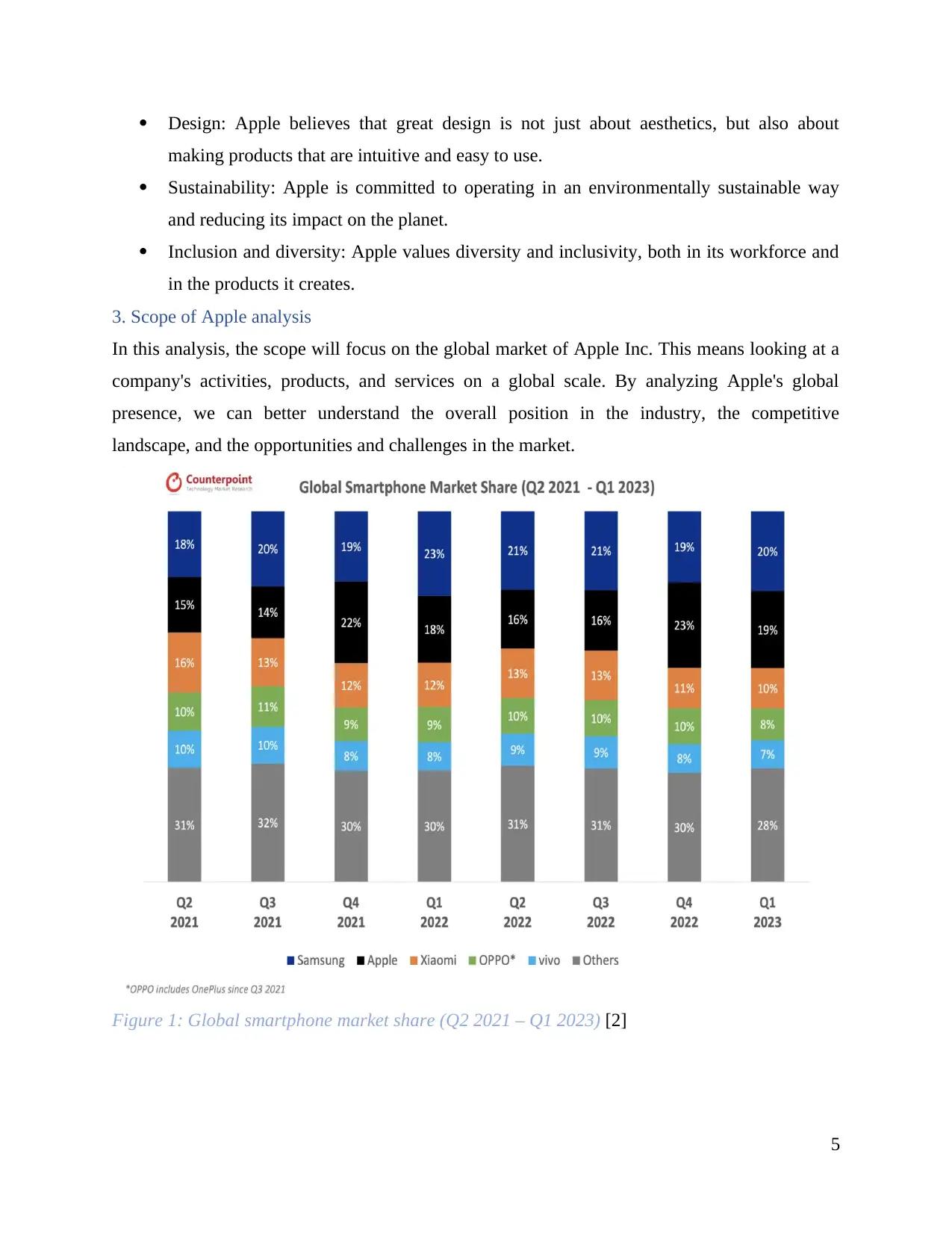
Design: Apple believes that great design is not just about aesthetics, but also about
making products that are intuitive and easy to use.
Sustainability: Apple is committed to operating in an environmentally sustainable way
and reducing its impact on the planet.
Inclusion and diversity: Apple values diversity and inclusivity, both in its workforce and
in the products it creates.
3. Scope of Apple analysis
In this analysis, the scope will focus on the global market of Apple Inc. This means looking at a
company's activities, products, and services on a global scale. By analyzing Apple's global
presence, we can better understand the overall position in the industry, the competitive
landscape, and the opportunities and challenges in the market.
Figure 1: Global smartphone market share (Q2 2021 – Q1 2023) [2]
5
making products that are intuitive and easy to use.
Sustainability: Apple is committed to operating in an environmentally sustainable way
and reducing its impact on the planet.
Inclusion and diversity: Apple values diversity and inclusivity, both in its workforce and
in the products it creates.
3. Scope of Apple analysis
In this analysis, the scope will focus on the global market of Apple Inc. This means looking at a
company's activities, products, and services on a global scale. By analyzing Apple's global
presence, we can better understand the overall position in the industry, the competitive
landscape, and the opportunities and challenges in the market.
Figure 1: Global smartphone market share (Q2 2021 – Q1 2023) [2]
5
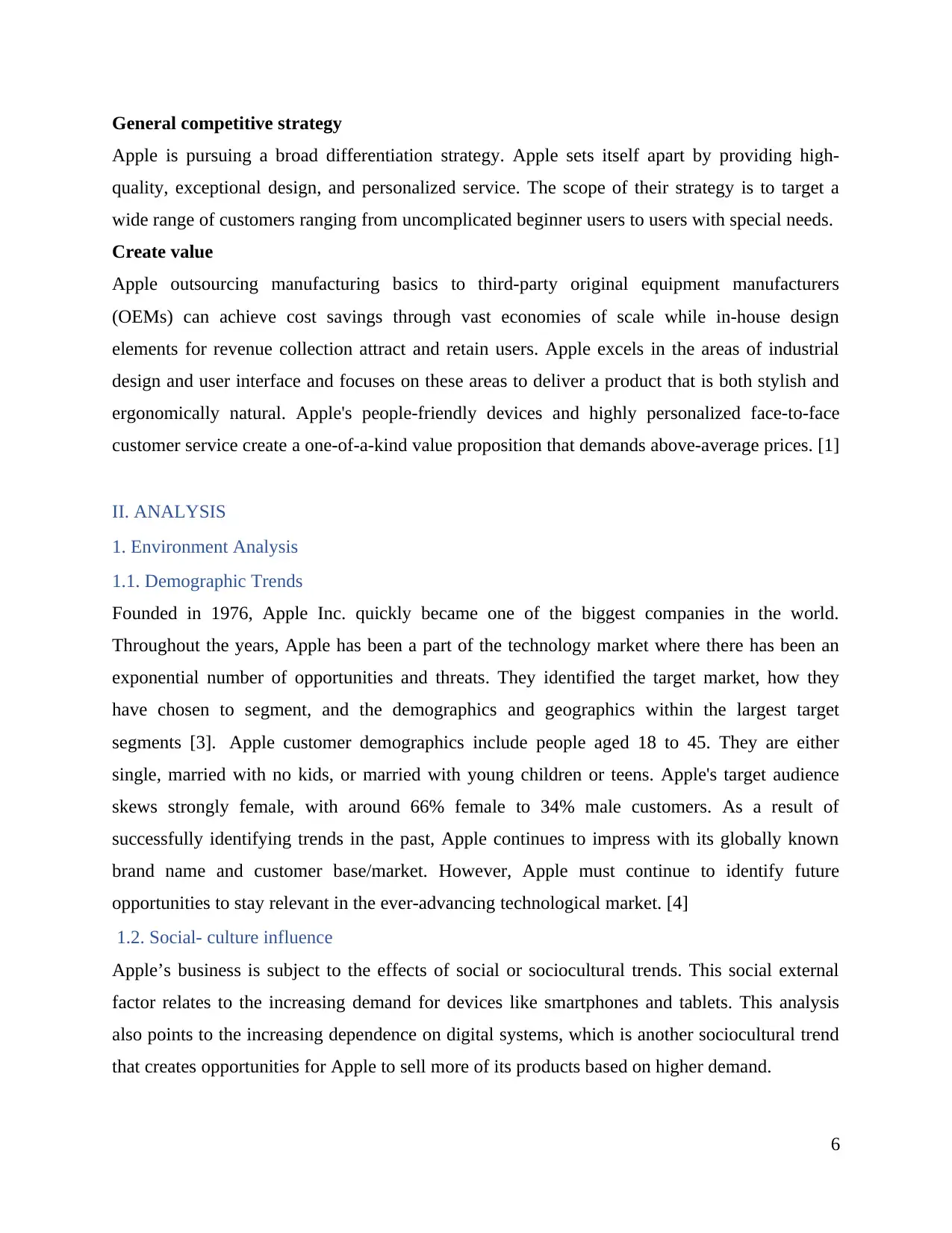
General competitive strategy
Apple is pursuing a broad differentiation strategy. Apple sets itself apart by providing high-
quality, exceptional design, and personalized service. The scope of their strategy is to target a
wide range of customers ranging from uncomplicated beginner users to users with special needs.
Create value
Apple outsourcing manufacturing basics to third-party original equipment manufacturers
(OEMs) can achieve cost savings through vast economies of scale while in-house design
elements for revenue collection attract and retain users. Apple excels in the areas of industrial
design and user interface and focuses on these areas to deliver a product that is both stylish and
ergonomically natural. Apple's people-friendly devices and highly personalized face-to-face
customer service create a one-of-a-kind value proposition that demands above-average prices. [1]
II. ANALYSIS
1. Environment Analysis
1.1. Demographic Trends
Founded in 1976, Apple Inc. quickly became one of the biggest companies in the world.
Throughout the years, Apple has been a part of the technology market where there has been an
exponential number of opportunities and threats. They identified the target market, how they
have chosen to segment, and the demographics and geographics within the largest target
segments [3]. Apple customer demographics include people aged 18 to 45. They are either
single, married with no kids, or married with young children or teens. Apple's target audience
skews strongly female, with around 66% female to 34% male customers. As a result of
successfully identifying trends in the past, Apple continues to impress with its globally known
brand name and customer base/market. However, Apple must continue to identify future
opportunities to stay relevant in the ever-advancing technological market. [4]
1.2. Social- culture influence
Apple’s business is subject to the effects of social or sociocultural trends. This social external
factor relates to the increasing demand for devices like smartphones and tablets. This analysis
also points to the increasing dependence on digital systems, which is another sociocultural trend
that creates opportunities for Apple to sell more of its products based on higher demand.
6
Apple is pursuing a broad differentiation strategy. Apple sets itself apart by providing high-
quality, exceptional design, and personalized service. The scope of their strategy is to target a
wide range of customers ranging from uncomplicated beginner users to users with special needs.
Create value
Apple outsourcing manufacturing basics to third-party original equipment manufacturers
(OEMs) can achieve cost savings through vast economies of scale while in-house design
elements for revenue collection attract and retain users. Apple excels in the areas of industrial
design and user interface and focuses on these areas to deliver a product that is both stylish and
ergonomically natural. Apple's people-friendly devices and highly personalized face-to-face
customer service create a one-of-a-kind value proposition that demands above-average prices. [1]
II. ANALYSIS
1. Environment Analysis
1.1. Demographic Trends
Founded in 1976, Apple Inc. quickly became one of the biggest companies in the world.
Throughout the years, Apple has been a part of the technology market where there has been an
exponential number of opportunities and threats. They identified the target market, how they
have chosen to segment, and the demographics and geographics within the largest target
segments [3]. Apple customer demographics include people aged 18 to 45. They are either
single, married with no kids, or married with young children or teens. Apple's target audience
skews strongly female, with around 66% female to 34% male customers. As a result of
successfully identifying trends in the past, Apple continues to impress with its globally known
brand name and customer base/market. However, Apple must continue to identify future
opportunities to stay relevant in the ever-advancing technological market. [4]
1.2. Social- culture influence
Apple’s business is subject to the effects of social or sociocultural trends. This social external
factor relates to the increasing demand for devices like smartphones and tablets. This analysis
also points to the increasing dependence on digital systems, which is another sociocultural trend
that creates opportunities for Apple to sell more of its products based on higher demand.
6
⊘ This is a preview!⊘
Do you want full access?
Subscribe today to unlock all pages.

Trusted by 1+ million students worldwide
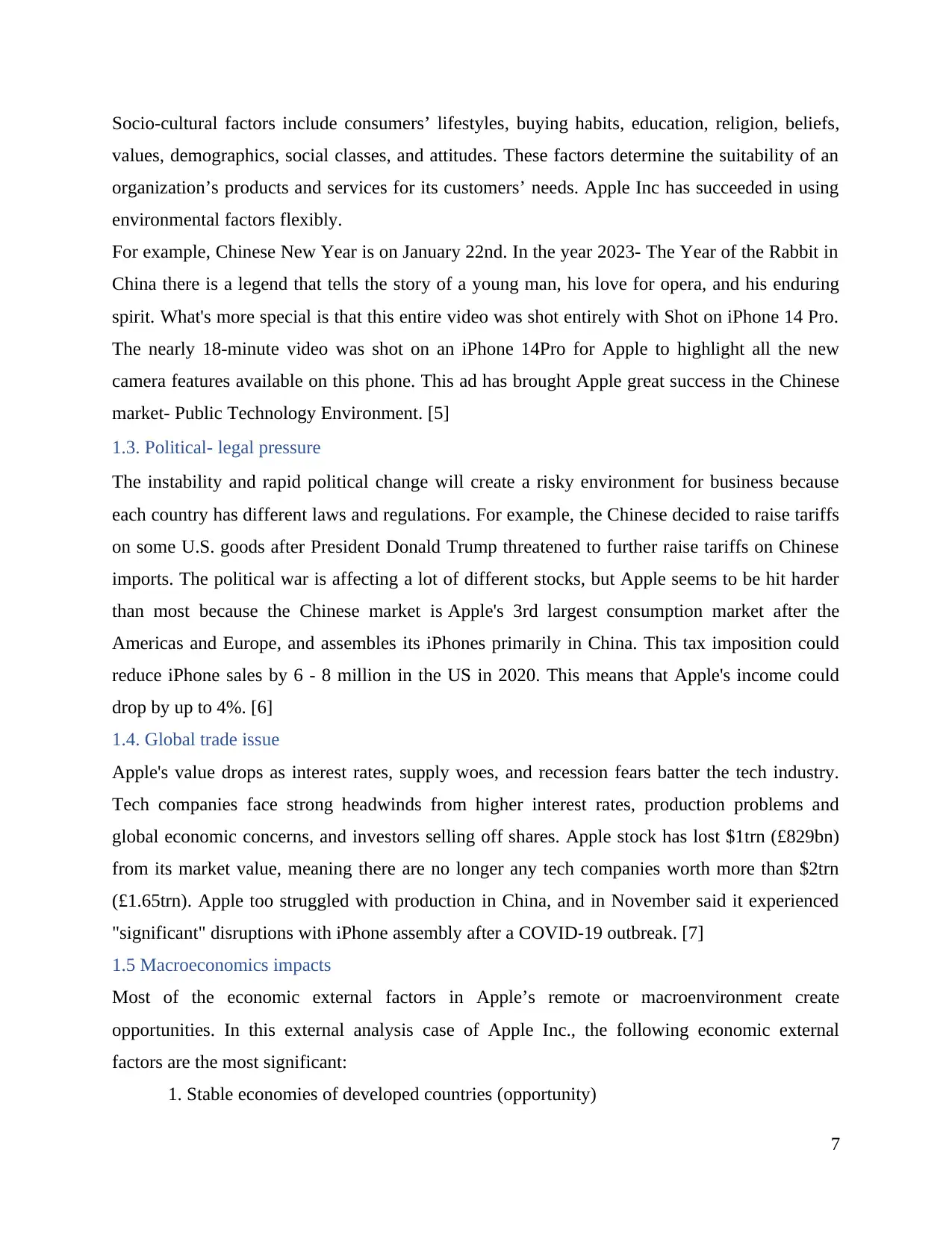
Socio-cultural factors include consumers’ lifestyles, buying habits, education, religion, beliefs,
values, demographics, social classes, and attitudes. These factors determine the suitability of an
organization’s products and services for its customers’ needs. Apple Inc has succeeded in using
environmental factors flexibly.
For example, Chinese New Year is on January 22nd. In the year 2023- The Year of the Rabbit in
China there is a legend that tells the story of a young man, his love for opera, and his enduring
spirit. What's more special is that this entire video was shot entirely with Shot on iPhone 14 Pro.
The nearly 18-minute video was shot on an iPhone 14Pro for Apple to highlight all the new
camera features available on this phone. This ad has brought Apple great success in the Chinese
market- Public Technology Environment. [5]
1.3. Political- legal pressure
The instability and rapid political change will create a risky environment for business because
each country has different laws and regulations. For example, the Chinese decided to raise tariffs
on some U.S. goods after President Donald Trump threatened to further raise tariffs on Chinese
imports. The political war is affecting a lot of different stocks, but Apple seems to be hit harder
than most because the Chinese market is Apple's 3rd largest consumption market after the
Americas and Europe, and assembles its iPhones primarily in China. This tax imposition could
reduce iPhone sales by 6 - 8 million in the US in 2020. This means that Apple's income could
drop by up to 4%. [6]
1.4. Global trade issue
Apple's value drops as interest rates, supply woes, and recession fears batter the tech industry.
Tech companies face strong headwinds from higher interest rates, production problems and
global economic concerns, and investors selling off shares. Apple stock has lost $1trn (£829bn)
from its market value, meaning there are no longer any tech companies worth more than $2trn
(£1.65trn). Apple too struggled with production in China, and in November said it experienced
"significant" disruptions with iPhone assembly after a COVID-19 outbreak. [7]
1.5 Macroeconomics impacts
Most of the economic external factors in Apple’s remote or macroenvironment create
opportunities. In this external analysis case of Apple Inc., the following economic external
factors are the most significant:
1. Stable economies of developed countries (opportunity)
7
values, demographics, social classes, and attitudes. These factors determine the suitability of an
organization’s products and services for its customers’ needs. Apple Inc has succeeded in using
environmental factors flexibly.
For example, Chinese New Year is on January 22nd. In the year 2023- The Year of the Rabbit in
China there is a legend that tells the story of a young man, his love for opera, and his enduring
spirit. What's more special is that this entire video was shot entirely with Shot on iPhone 14 Pro.
The nearly 18-minute video was shot on an iPhone 14Pro for Apple to highlight all the new
camera features available on this phone. This ad has brought Apple great success in the Chinese
market- Public Technology Environment. [5]
1.3. Political- legal pressure
The instability and rapid political change will create a risky environment for business because
each country has different laws and regulations. For example, the Chinese decided to raise tariffs
on some U.S. goods after President Donald Trump threatened to further raise tariffs on Chinese
imports. The political war is affecting a lot of different stocks, but Apple seems to be hit harder
than most because the Chinese market is Apple's 3rd largest consumption market after the
Americas and Europe, and assembles its iPhones primarily in China. This tax imposition could
reduce iPhone sales by 6 - 8 million in the US in 2020. This means that Apple's income could
drop by up to 4%. [6]
1.4. Global trade issue
Apple's value drops as interest rates, supply woes, and recession fears batter the tech industry.
Tech companies face strong headwinds from higher interest rates, production problems and
global economic concerns, and investors selling off shares. Apple stock has lost $1trn (£829bn)
from its market value, meaning there are no longer any tech companies worth more than $2trn
(£1.65trn). Apple too struggled with production in China, and in November said it experienced
"significant" disruptions with iPhone assembly after a COVID-19 outbreak. [7]
1.5 Macroeconomics impacts
Most of the economic external factors in Apple’s remote or macroenvironment create
opportunities. In this external analysis case of Apple Inc., the following economic external
factors are the most significant:
1. Stable economies of developed countries (opportunity)
7
Paraphrase This Document
Need a fresh take? Get an instant paraphrase of this document with our AI Paraphraser
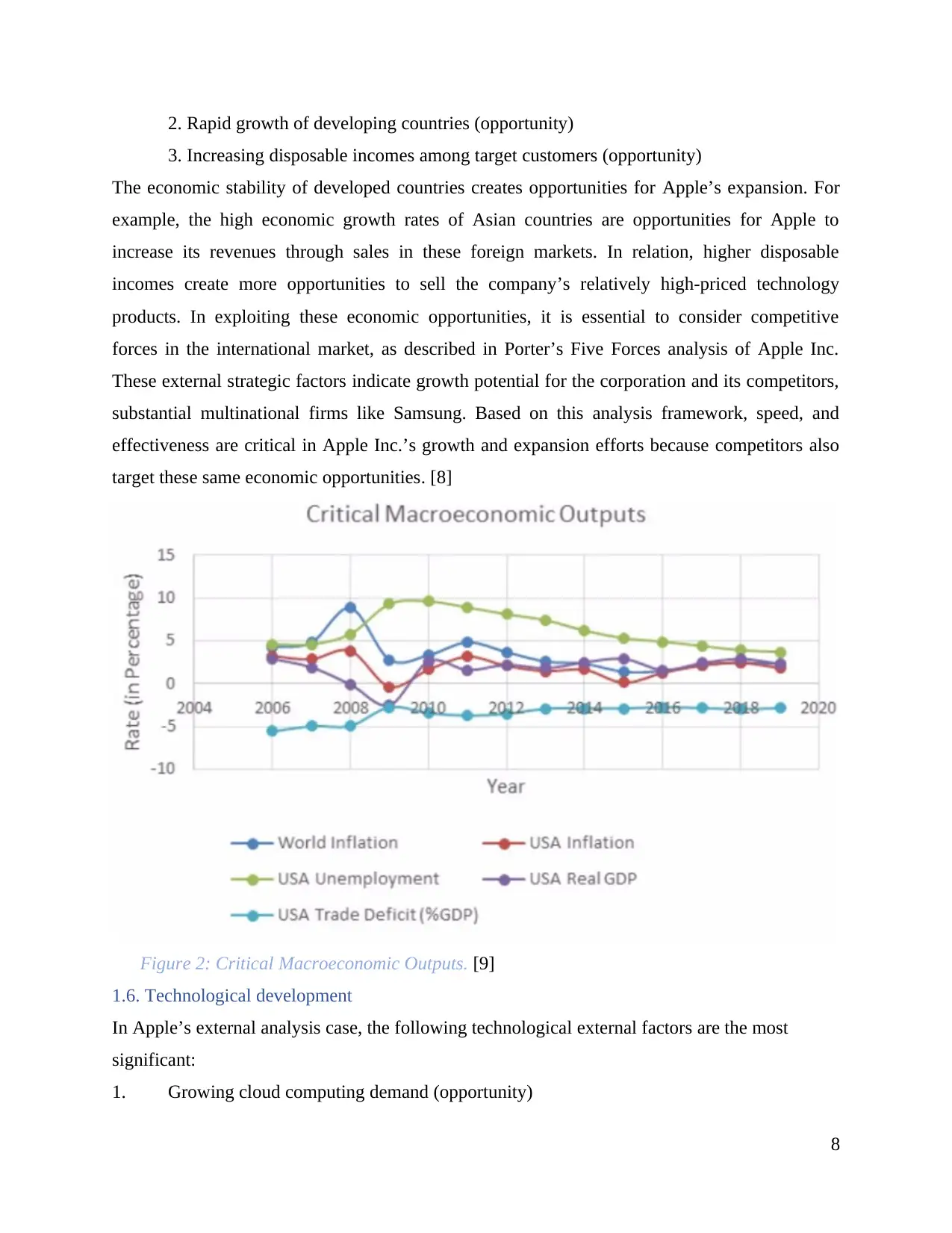
2. Rapid growth of developing countries (opportunity)
3. Increasing disposable incomes among target customers (opportunity)
The economic stability of developed countries creates opportunities for Apple’s expansion. For
example, the high economic growth rates of Asian countries are opportunities for Apple to
increase its revenues through sales in these foreign markets. In relation, higher disposable
incomes create more opportunities to sell the company’s relatively high-priced technology
products. In exploiting these economic opportunities, it is essential to consider competitive
forces in the international market, as described in Porter’s Five Forces analysis of Apple Inc.
These external strategic factors indicate growth potential for the corporation and its competitors,
substantial multinational firms like Samsung. Based on this analysis framework, speed, and
effectiveness are critical in Apple Inc.’s growth and expansion efforts because competitors also
target these same economic opportunities. [8]
Figure 2: Critical Macroeconomic Outputs. [9]
1.6. Technological development
In Apple’s external analysis case, the following technological external factors are the most
significant:
1. Growing cloud computing demand (opportunity)
8
3. Increasing disposable incomes among target customers (opportunity)
The economic stability of developed countries creates opportunities for Apple’s expansion. For
example, the high economic growth rates of Asian countries are opportunities for Apple to
increase its revenues through sales in these foreign markets. In relation, higher disposable
incomes create more opportunities to sell the company’s relatively high-priced technology
products. In exploiting these economic opportunities, it is essential to consider competitive
forces in the international market, as described in Porter’s Five Forces analysis of Apple Inc.
These external strategic factors indicate growth potential for the corporation and its competitors,
substantial multinational firms like Samsung. Based on this analysis framework, speed, and
effectiveness are critical in Apple Inc.’s growth and expansion efforts because competitors also
target these same economic opportunities. [8]
Figure 2: Critical Macroeconomic Outputs. [9]
1.6. Technological development
In Apple’s external analysis case, the following technological external factors are the most
significant:
1. Growing cloud computing demand (opportunity)
8
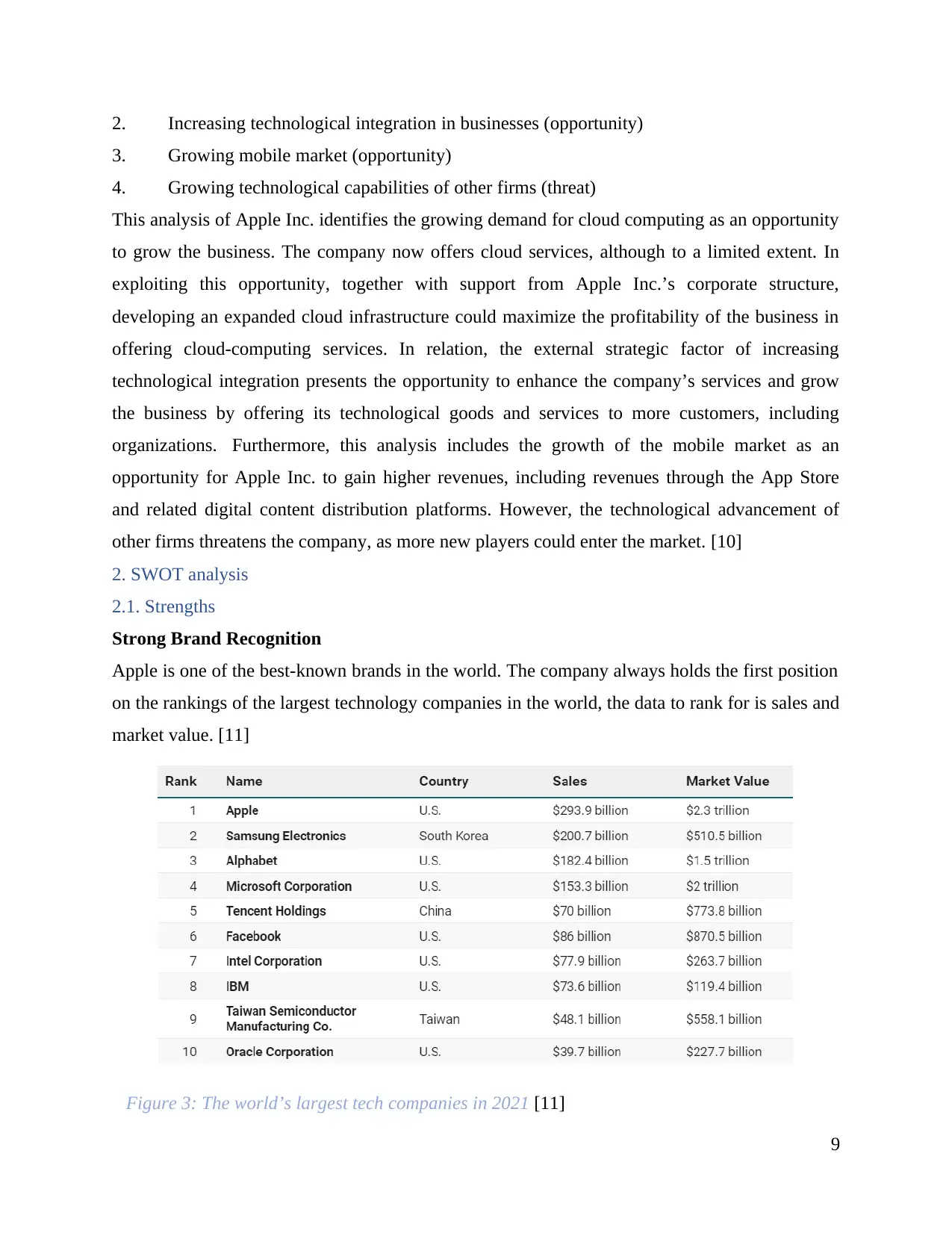
2. Increasing technological integration in businesses (opportunity)
3. Growing mobile market (opportunity)
4. Growing technological capabilities of other firms (threat)
This analysis of Apple Inc. identifies the growing demand for cloud computing as an opportunity
to grow the business. The company now offers cloud services, although to a limited extent. In
exploiting this opportunity, together with support from Apple Inc.’s corporate structure,
developing an expanded cloud infrastructure could maximize the profitability of the business in
offering cloud-computing services. In relation, the external strategic factor of increasing
technological integration presents the opportunity to enhance the company’s services and grow
the business by offering its technological goods and services to more customers, including
organizations. Furthermore, this analysis includes the growth of the mobile market as an
opportunity for Apple Inc. to gain higher revenues, including revenues through the App Store
and related digital content distribution platforms. However, the technological advancement of
other firms threatens the company, as more new players could enter the market. [10]
2. SWOT analysis
2.1. Strengths
Strong Brand Recognition
Apple is one of the best-known brands in the world. The company always holds the first position
on the rankings of the largest technology companies in the world, the data to rank for is sales and
market value. [11]
Figure 3: The world’s largest tech companies in 2021 [11]
9
3. Growing mobile market (opportunity)
4. Growing technological capabilities of other firms (threat)
This analysis of Apple Inc. identifies the growing demand for cloud computing as an opportunity
to grow the business. The company now offers cloud services, although to a limited extent. In
exploiting this opportunity, together with support from Apple Inc.’s corporate structure,
developing an expanded cloud infrastructure could maximize the profitability of the business in
offering cloud-computing services. In relation, the external strategic factor of increasing
technological integration presents the opportunity to enhance the company’s services and grow
the business by offering its technological goods and services to more customers, including
organizations. Furthermore, this analysis includes the growth of the mobile market as an
opportunity for Apple Inc. to gain higher revenues, including revenues through the App Store
and related digital content distribution platforms. However, the technological advancement of
other firms threatens the company, as more new players could enter the market. [10]
2. SWOT analysis
2.1. Strengths
Strong Brand Recognition
Apple is one of the best-known brands in the world. The company always holds the first position
on the rankings of the largest technology companies in the world, the data to rank for is sales and
market value. [11]
Figure 3: The world’s largest tech companies in 2021 [11]
9
⊘ This is a preview!⊘
Do you want full access?
Subscribe today to unlock all pages.

Trusted by 1+ million students worldwide
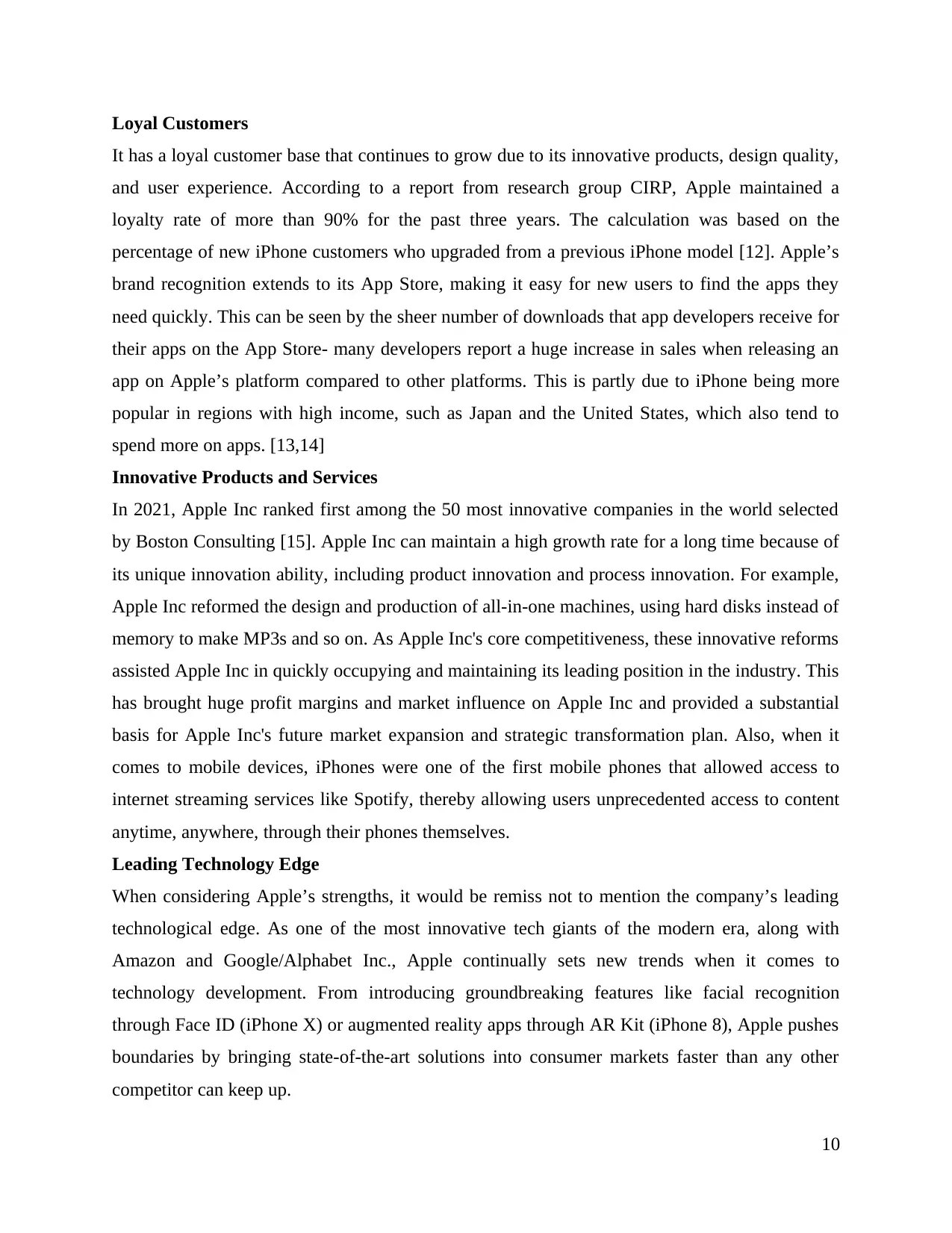
Loyal Customers
It has a loyal customer base that continues to grow due to its innovative products, design quality,
and user experience. According to a report from research group CIRP, Apple maintained a
loyalty rate of more than 90% for the past three years. The calculation was based on the
percentage of new iPhone customers who upgraded from a previous iPhone model [12]. Apple’s
brand recognition extends to its App Store, making it easy for new users to find the apps they
need quickly. This can be seen by the sheer number of downloads that app developers receive for
their apps on the App Store- many developers report a huge increase in sales when releasing an
app on Apple’s platform compared to other platforms. This is partly due to iPhone being more
popular in regions with high income, such as Japan and the United States, which also tend to
spend more on apps. [13,14]
Innovative Products and Services
In 2021, Apple Inc ranked first among the 50 most innovative companies in the world selected
by Boston Consulting [15]. Apple Inc can maintain a high growth rate for a long time because of
its unique innovation ability, including product innovation and process innovation. For example,
Apple Inc reformed the design and production of all-in-one machines, using hard disks instead of
memory to make MP3s and so on. As Apple Inc's core competitiveness, these innovative reforms
assisted Apple Inc in quickly occupying and maintaining its leading position in the industry. This
has brought huge profit margins and market influence on Apple Inc and provided a substantial
basis for Apple Inc's future market expansion and strategic transformation plan. Also, when it
comes to mobile devices, iPhones were one of the first mobile phones that allowed access to
internet streaming services like Spotify, thereby allowing users unprecedented access to content
anytime, anywhere, through their phones themselves.
Leading Technology Edge
When considering Apple’s strengths, it would be remiss not to mention the company’s leading
technological edge. As one of the most innovative tech giants of the modern era, along with
Amazon and Google/Alphabet Inc., Apple continually sets new trends when it comes to
technology development. From introducing groundbreaking features like facial recognition
through Face ID (iPhone X) or augmented reality apps through AR Kit (iPhone 8), Apple pushes
boundaries by bringing state-of-the-art solutions into consumer markets faster than any other
competitor can keep up.
10
It has a loyal customer base that continues to grow due to its innovative products, design quality,
and user experience. According to a report from research group CIRP, Apple maintained a
loyalty rate of more than 90% for the past three years. The calculation was based on the
percentage of new iPhone customers who upgraded from a previous iPhone model [12]. Apple’s
brand recognition extends to its App Store, making it easy for new users to find the apps they
need quickly. This can be seen by the sheer number of downloads that app developers receive for
their apps on the App Store- many developers report a huge increase in sales when releasing an
app on Apple’s platform compared to other platforms. This is partly due to iPhone being more
popular in regions with high income, such as Japan and the United States, which also tend to
spend more on apps. [13,14]
Innovative Products and Services
In 2021, Apple Inc ranked first among the 50 most innovative companies in the world selected
by Boston Consulting [15]. Apple Inc can maintain a high growth rate for a long time because of
its unique innovation ability, including product innovation and process innovation. For example,
Apple Inc reformed the design and production of all-in-one machines, using hard disks instead of
memory to make MP3s and so on. As Apple Inc's core competitiveness, these innovative reforms
assisted Apple Inc in quickly occupying and maintaining its leading position in the industry. This
has brought huge profit margins and market influence on Apple Inc and provided a substantial
basis for Apple Inc's future market expansion and strategic transformation plan. Also, when it
comes to mobile devices, iPhones were one of the first mobile phones that allowed access to
internet streaming services like Spotify, thereby allowing users unprecedented access to content
anytime, anywhere, through their phones themselves.
Leading Technology Edge
When considering Apple’s strengths, it would be remiss not to mention the company’s leading
technological edge. As one of the most innovative tech giants of the modern era, along with
Amazon and Google/Alphabet Inc., Apple continually sets new trends when it comes to
technology development. From introducing groundbreaking features like facial recognition
through Face ID (iPhone X) or augmented reality apps through AR Kit (iPhone 8), Apple pushes
boundaries by bringing state-of-the-art solutions into consumer markets faster than any other
competitor can keep up.
10
Paraphrase This Document
Need a fresh take? Get an instant paraphrase of this document with our AI Paraphraser
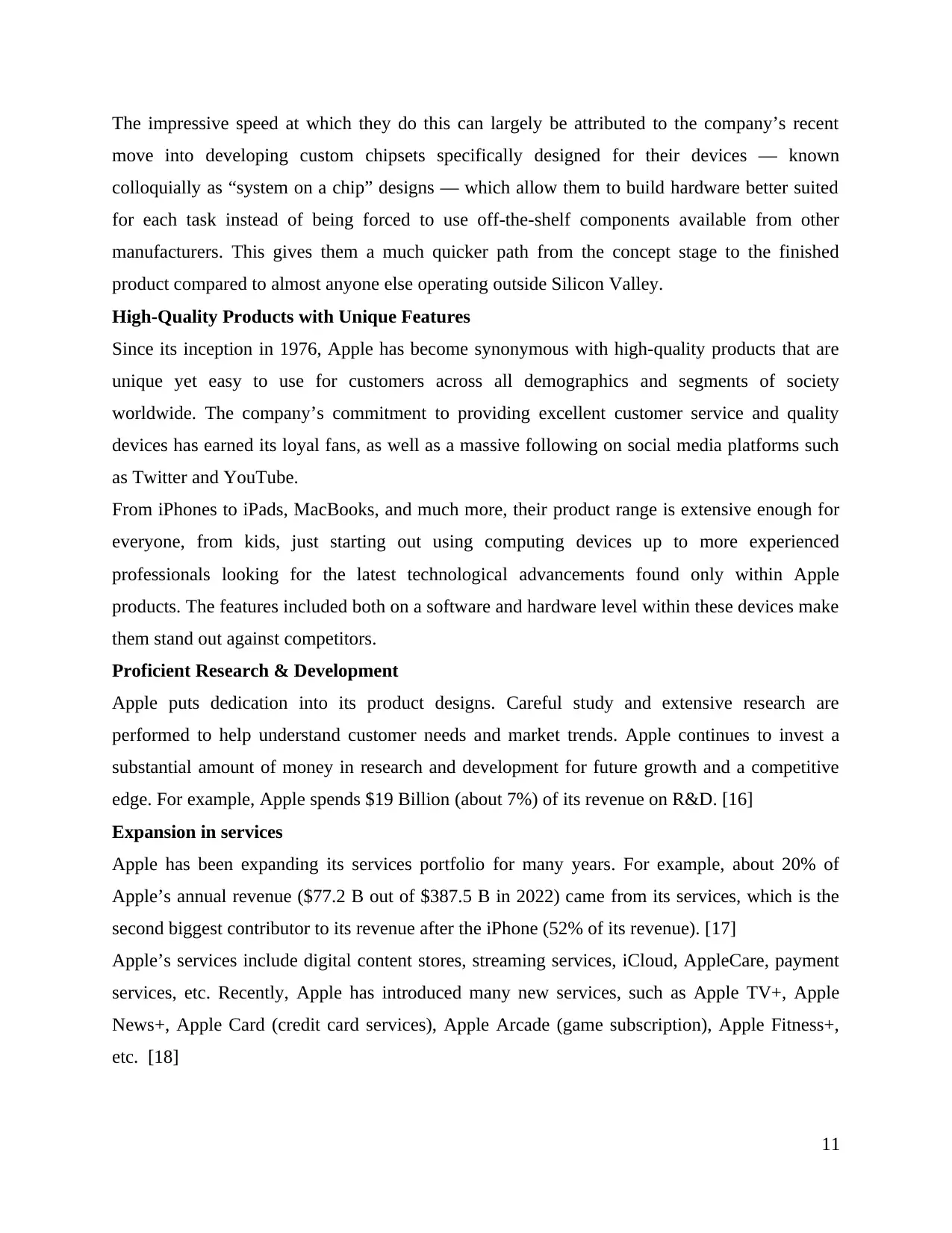
The impressive speed at which they do this can largely be attributed to the company’s recent
move into developing custom chipsets specifically designed for their devices — known
colloquially as “system on a chip” designs — which allow them to build hardware better suited
for each task instead of being forced to use off-the-shelf components available from other
manufacturers. This gives them a much quicker path from the concept stage to the finished
product compared to almost anyone else operating outside Silicon Valley.
High-Quality Products with Unique Features
Since its inception in 1976, Apple has become synonymous with high-quality products that are
unique yet easy to use for customers across all demographics and segments of society
worldwide. The company’s commitment to providing excellent customer service and quality
devices has earned its loyal fans, as well as a massive following on social media platforms such
as Twitter and YouTube.
From iPhones to iPads, MacBooks, and much more, their product range is extensive enough for
everyone, from kids, just starting out using computing devices up to more experienced
professionals looking for the latest technological advancements found only within Apple
products. The features included both on a software and hardware level within these devices make
them stand out against competitors.
Proficient Research & Development
Apple puts dedication into its product designs. Careful study and extensive research are
performed to help understand customer needs and market trends. Apple continues to invest a
substantial amount of money in research and development for future growth and a competitive
edge. For example, Apple spends $19 Billion (about 7%) of its revenue on R&D. [16]
Expansion in services
Apple has been expanding its services portfolio for many years. For example, about 20% of
Apple’s annual revenue ($77.2 B out of $387.5 B in 2022) came from its services, which is the
second biggest contributor to its revenue after the iPhone (52% of its revenue). [17]
Apple’s services include digital content stores, streaming services, iCloud, AppleCare, payment
services, etc. Recently, Apple has introduced many new services, such as Apple TV+, Apple
News+, Apple Card (credit card services), Apple Arcade (game subscription), Apple Fitness+,
etc. [18]
11
move into developing custom chipsets specifically designed for their devices — known
colloquially as “system on a chip” designs — which allow them to build hardware better suited
for each task instead of being forced to use off-the-shelf components available from other
manufacturers. This gives them a much quicker path from the concept stage to the finished
product compared to almost anyone else operating outside Silicon Valley.
High-Quality Products with Unique Features
Since its inception in 1976, Apple has become synonymous with high-quality products that are
unique yet easy to use for customers across all demographics and segments of society
worldwide. The company’s commitment to providing excellent customer service and quality
devices has earned its loyal fans, as well as a massive following on social media platforms such
as Twitter and YouTube.
From iPhones to iPads, MacBooks, and much more, their product range is extensive enough for
everyone, from kids, just starting out using computing devices up to more experienced
professionals looking for the latest technological advancements found only within Apple
products. The features included both on a software and hardware level within these devices make
them stand out against competitors.
Proficient Research & Development
Apple puts dedication into its product designs. Careful study and extensive research are
performed to help understand customer needs and market trends. Apple continues to invest a
substantial amount of money in research and development for future growth and a competitive
edge. For example, Apple spends $19 Billion (about 7%) of its revenue on R&D. [16]
Expansion in services
Apple has been expanding its services portfolio for many years. For example, about 20% of
Apple’s annual revenue ($77.2 B out of $387.5 B in 2022) came from its services, which is the
second biggest contributor to its revenue after the iPhone (52% of its revenue). [17]
Apple’s services include digital content stores, streaming services, iCloud, AppleCare, payment
services, etc. Recently, Apple has introduced many new services, such as Apple TV+, Apple
News+, Apple Card (credit card services), Apple Arcade (game subscription), Apple Fitness+,
etc. [18]
11
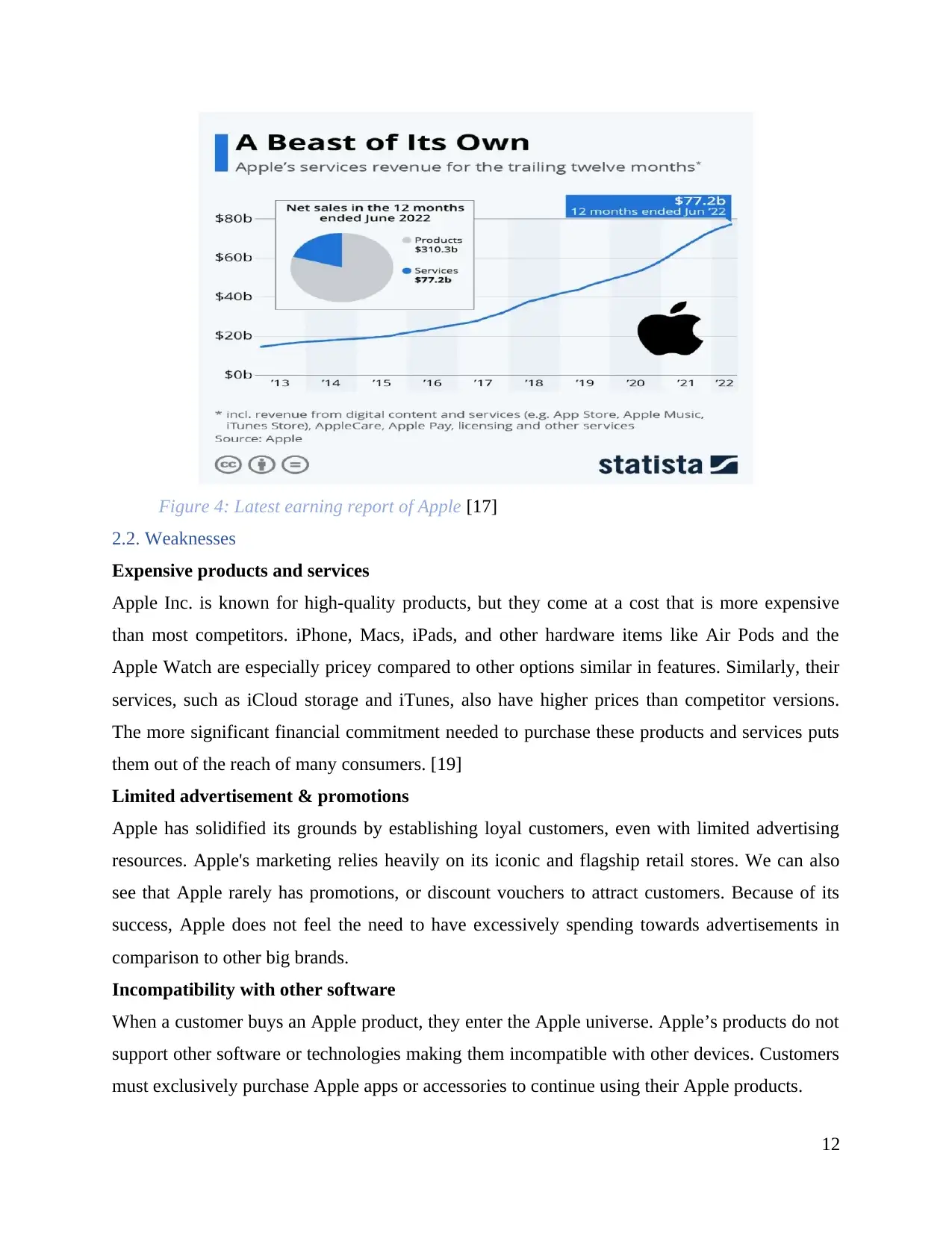
Figure 4: Latest earning report of Apple [17]
2.2. Weaknesses
Expensive products and services
Apple Inc. is known for high-quality products, but they come at a cost that is more expensive
than most competitors. iPhone, Macs, iPads, and other hardware items like Air Pods and the
Apple Watch are especially pricey compared to other options similar in features. Similarly, their
services, such as iCloud storage and iTunes, also have higher prices than competitor versions.
The more significant financial commitment needed to purchase these products and services puts
them out of the reach of many consumers. [19]
Limited advertisement & promotions
Apple has solidified its grounds by establishing loyal customers, even with limited advertising
resources. Apple's marketing relies heavily on its iconic and flagship retail stores. We can also
see that Apple rarely has promotions, or discount vouchers to attract customers. Because of its
success, Apple does not feel the need to have excessively spending towards advertisements in
comparison to other big brands.
Incompatibility with other software
When a customer buys an Apple product, they enter the Apple universe. Apple’s products do not
support other software or technologies making them incompatible with other devices. Customers
must exclusively purchase Apple apps or accessories to continue using their Apple products.
12
2.2. Weaknesses
Expensive products and services
Apple Inc. is known for high-quality products, but they come at a cost that is more expensive
than most competitors. iPhone, Macs, iPads, and other hardware items like Air Pods and the
Apple Watch are especially pricey compared to other options similar in features. Similarly, their
services, such as iCloud storage and iTunes, also have higher prices than competitor versions.
The more significant financial commitment needed to purchase these products and services puts
them out of the reach of many consumers. [19]
Limited advertisement & promotions
Apple has solidified its grounds by establishing loyal customers, even with limited advertising
resources. Apple's marketing relies heavily on its iconic and flagship retail stores. We can also
see that Apple rarely has promotions, or discount vouchers to attract customers. Because of its
success, Apple does not feel the need to have excessively spending towards advertisements in
comparison to other big brands.
Incompatibility with other software
When a customer buys an Apple product, they enter the Apple universe. Apple’s products do not
support other software or technologies making them incompatible with other devices. Customers
must exclusively purchase Apple apps or accessories to continue using their Apple products.
12
⊘ This is a preview!⊘
Do you want full access?
Subscribe today to unlock all pages.

Trusted by 1+ million students worldwide
1 out of 22
Related Documents
Your All-in-One AI-Powered Toolkit for Academic Success.
+13062052269
info@desklib.com
Available 24*7 on WhatsApp / Email
![[object Object]](/_next/static/media/star-bottom.7253800d.svg)
Unlock your academic potential
Copyright © 2020–2025 A2Z Services. All Rights Reserved. Developed and managed by ZUCOL.





